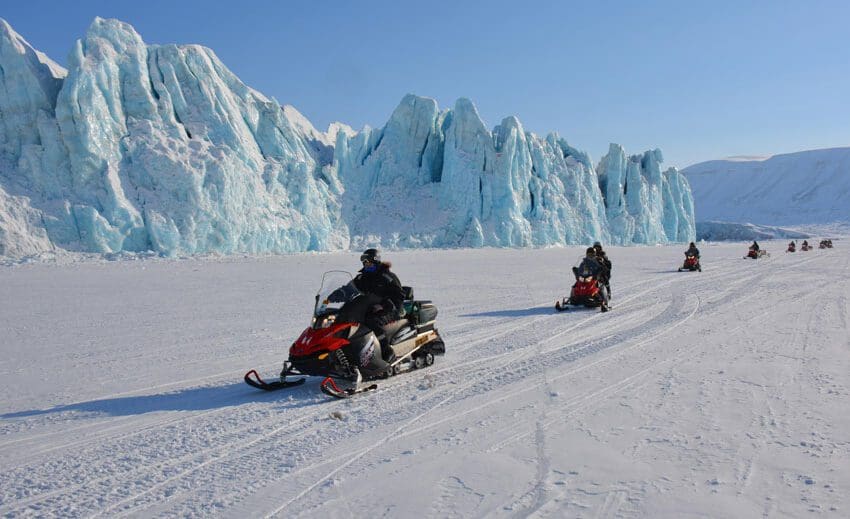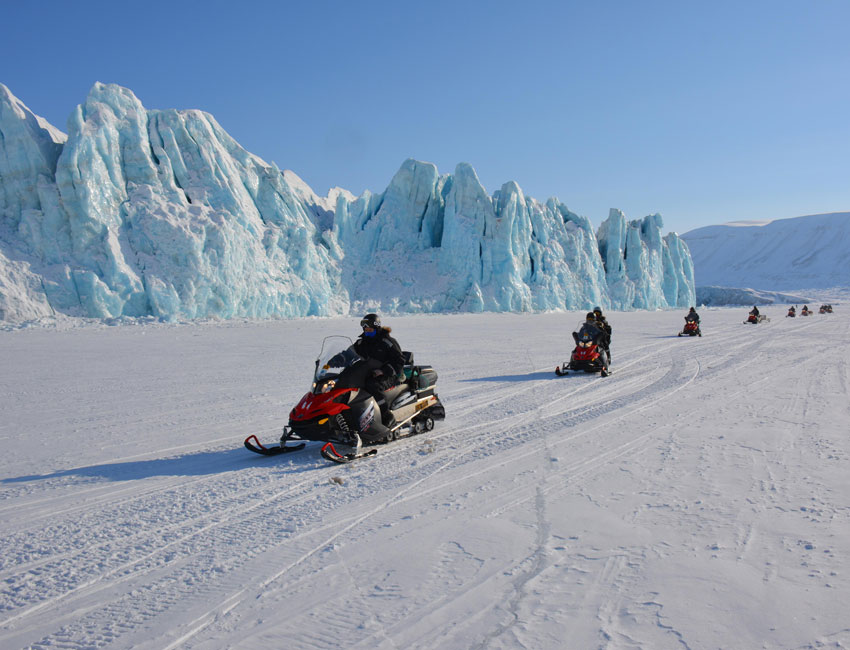AG-842 The Marine Cryosphere and its Cenozoic History (10 ECTS)
ID:
AG-842
CREDITS:
10 ECTS
APPLICATION DEADLINE:
October 01, 2024
START DATE:
March 03, 2025
END DATE:
April 11, 2025
COURSE PERIOD:
Spring semester. Teaching block 2

AG-342/842 excursion to Tunabreen. Photo: Riko Noormets/UNIS.
| Grade: | Letter grade (A through F) |
| Course Cost: | Fieldwork, NOK 400–1000 (2–5 days x NOK 200 per overnight stay) |
| Course Capacity Min/Max: | 10/20 students (AG-342/842 in total) |
| Language of instruction: | English |
| Examination support material: | Bilingual dictionary between English and mother tongue |
UNIS contact person:
Course requirements
Enrolment in a PhD programme in Earth sciences. Fundamentals of geology especially within sedimentology, corresponding to AG-209, AG-210 or AG-211, or equivalent.
Academic content
The term marine cryosphere is used to collectively describe frozen water within the marine portion of the Earth’s surface. This incorporates marine based ice sheets including ice shelves and ice streams, icebergs, sea ice, and subsea permafrost. The marine cryosphere has played a key role during several time periods of the Earth’s geological history and is a critical component in studies of climate change. In this course, the students will learn about the evolution of the marine cryosphere during the Cenozoic when the Earth’s experienced a long term palaeoclimatic change from the warm greenhouse to the colder icehouse world.
The course embraces the marine environment from shallow shelves to the deep ocean. Arctic and Antarctic analogies and differences with respect to the Cenozoic history of the marine cryosphere will be discussed.
The main topics of the course are:
- General physical characteristics of the marine cryosphere: marine based ice sheets, icebergs, sea ice and subsea permafrost
- Dynamics of marine based ice sheets and sea ice
- Marine glaciogenic landforms: mapping and interpretation
- Sea ice and glacial sediment proxies: from biomarkers to ice rafted debris
- Past and present drift patterns of sea ice and icebergs: implications for interpretation of palaeo-proxies
- The Cenozoic history of the marine cryosphere
- Ice sheet modelling: limitations and possibilities to simulate the marine components
- The cryosphere’s interaction with the marine environment and climate
Geological/geophysical data, providing information on the spatial extent and dynamics of the Svalbard-Barents ice sheet during the Last Glacial Maximum, are compared with ice sheet modelling results in the laboratory computer exercises. This will give the students a direct insight into the present limitations and possibilities to simulate the key components of marine based ice sheets; ice streams and ice shelves.
Learning outcomes
Upon completing the course, the students will have:
Knowledge
- Knowledge about the Cenozoic history of the marine cryosphere and physical characteristics of its components, and their interaction with the marine environment and climate.
- A general understanding of the main survey methods and tools applied to study the marine cryosphere.
- Knowledge of the main palaeo proxies used to study the marine cryosphere’s Cenozoic history.
- Understanding of capabilities and limitations of numerical ice sheet models.
- An ability to place the current knowledge of the marine cryosphere in the context of the historical literature on the subject.
Skills
- Practical skills on analysis of geological records, such as mapped marine glaciogenic landforms and sediment cores, that can be used to reconstruct the palaeo-history of the marine cryosphere.
- Practical skills from assisting in data acquisition during fieldwork.
- Analytical skills to determine limitations and possibilities in modelling studies of marine ice sheets including ice shelves and ice streams.
- Ability to design and carry out a research project and by synthesizing the results with data from various sources, explain and challenge the existing theories.
General competences
- Basic experience in Arctic fieldwork planning and execution.
- Independent as well as team-work skills.
- Independent research writing skills on given topic.
- Presentation skills, written and oral.
- Skills in communicating current research topics to the public.
Learning activities
The course extends over ca 5 weeks including compulsory safety training, and is run in combination with AG-342 The Marine Cryosphere and its Cenozoic History (10 ECTS).
Prior to the course, as a pre-course assignment, the students are asked to prepare a short talk about their PhD projects specifying its relevance to the content of the course and present it in a seminar early in the course.
Through the lectures, fieldwork, lab exercises and individual project work, the students will be introduced to the marine cryosphere and its components. Specific emphasis is placed on describing and discussing available methods to study the geological history of the marine cryosphere.
The course includes 2–5 days fieldwork based on the sea ice in front of one of Svalbard’s tidewater glaciers. The fieldwork will give students first-hand experience of geophysical, geological and oceanographic data collection and sampling procedures.
In a seminar towards the end of the course the students will present the results of their course projects in a 10–15 min. oral presentation to the class for discussion. Finally the students will, as part of the course assessment, complete a scientific project report.
Summary
- Total lecture hours, seminars and practical exercises: Ca. 50 hours.
- Fieldwork: 2–5 days.
Compulsory learning activities
All compulsory learning activities must be approved in order to sit the exam.
- Fieldwork/cruise
- Two seminars
- Two oral presentations (one at each seminar)
Assessment
- All assessments must be passed in order to pass the course.
- Each assessment is graded, and subsequently combined into a single grade. Partial grades for each assessment will be available
| Method | Duration |
Percentage of final grade
|
| Written project report | 30% | |
| Written exam | 4 hours | 70% |
Student life


